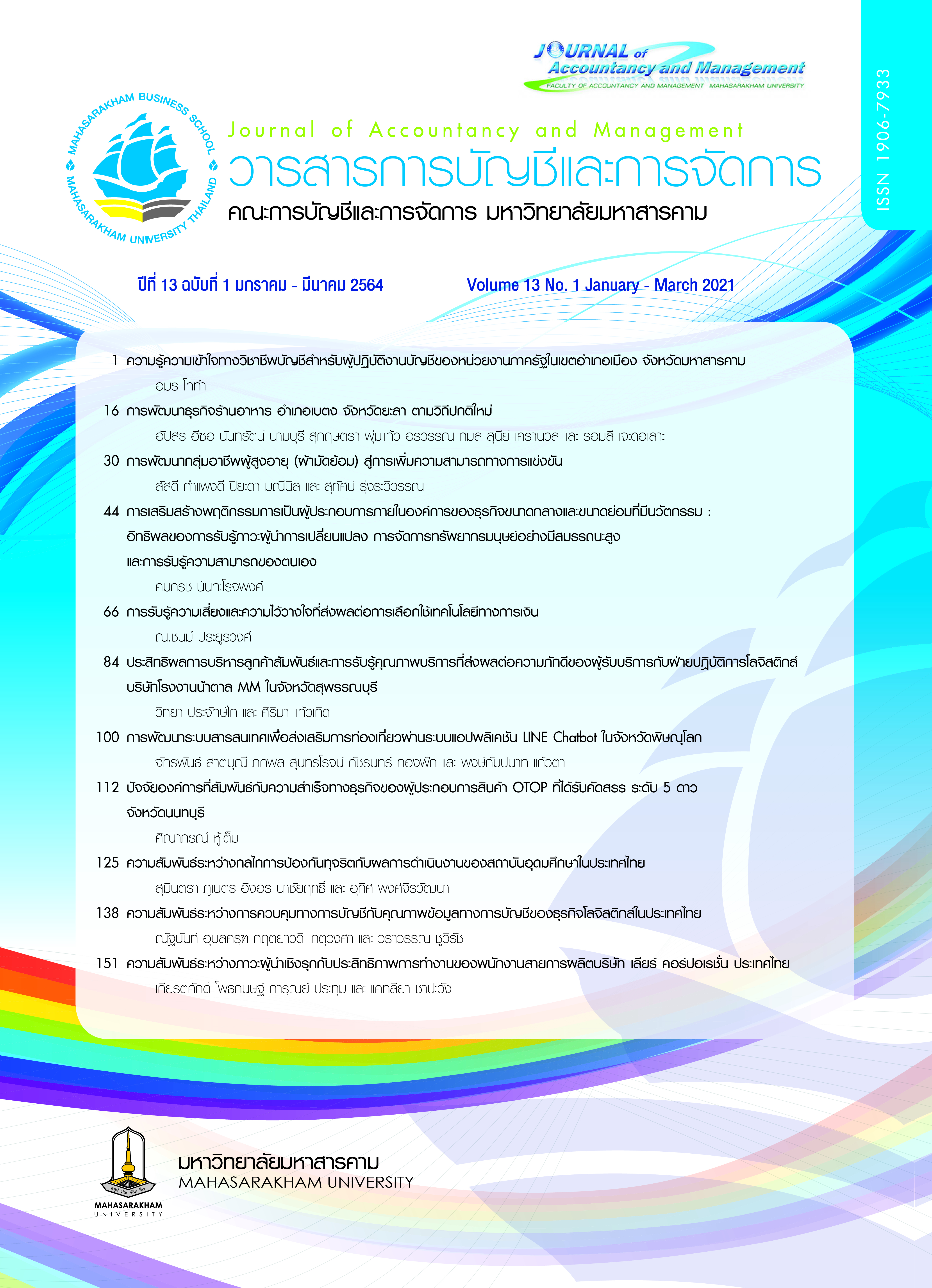การพัฒนากลุ่มอาชีพผู้สูงอายุ (ผ้ามัดย้อม) สู่การเพิ่มความสามารถทางการแข่งขัน
Main Article Content
บทคัดย่อ
บทคัดย่อ
งานวิจัยนี้เป็นการพัฒนาผู้สูงอายุเชิงปฏิบัติการแบบมีส่วนร่วม มีวัตถุประสงค์เพื่อศึกษาข้อมูลพื้นฐาน สภาพการดำเนินงานของผู้สูงอายุและความต้องการพัฒนากลุ่มอาชีพผู้สูงอายุ กลุ่มเป้าหมายประกอบด้วย สมาชิกกลุ่มผู้สูงอายุ จำนวน 10 คน เก็บรวบรวมข้อมูลด้วยแบบสัมภาษณ์ การสนทนากลุ่ม การระดมสมอง การสรุปบทเรียน ทำการวิเคราะห์ข้อมูลด้วยการสรุปประเด็นและสถิติเชิงพรรณนาและตรวจสอบความถูกต้องของข้อมูลแบบสามเส้า ผลการวิจัย พบว่า
ในระยะก่อนเริ่มดำเนินการ กลุ่มผู้สูงอายุมีความพร้อมในการพัฒนาและได้รับการสนับสนุนจากโรงเรียนผู้สูงอายุ แต่ยังขาดความรู้ทางธุรกิจและงบประมาณในการดำเนินงาน ระยะปฏิบัติการ ดำเนินการประชุมกลุ่มเพื่อระดมความคิดร่วมกันและทำการพัฒนาผลิตภัณฑ์ผ้ามัดย้อมได้ 3 รูปแบบ คือ เสื้อมัดย้อม ผ้าผืนมัดย้อมและกระเป๋าผ้ามัดย้อม โดยมีคณะนักวิจัยและผู้เชี่ยวชาญช่วยพัฒนาจนสามารถดำเนินการเองได้ทั้งหมดและมีการวางแผนยกระดับเพื่อเข้าสู่วิสาหกิจชุมชน เพื่อให้ผลิตภัณฑ์เป็นที่รู้จักมากขึ้น ระยะติดตามและประเมินผล พบการพัฒนาผ้ามัดย้อมประสบผลสำเร็จ ทำให้เกิดผลิตภัณฑ์ผ้ามัดย้อมรูปแบบใหม่ ผู้เชี่ยวชาญและสมาชิกกลุ่มผู้สูงอายุมีความพึงพอใจในการพัฒนาผลิตภัณฑ์อยู่ในระดับมากที่สุด ซึ่งพิจารณาจาก โครงสร้างผลิตภัณฑ์ วัสดุ
ความสวยงาม ประโยชน์ใช้สอยและการดูแลรักษา ปัจจัยที่ทำให้เกิดความสำเร็จนี้มาจากการมีส่วนร่วมและการเรียนรู้ร่วมกัน ซึ่งได้ข้อเสนอแนะจากการวิจัย ควรให้กลุ่มอาชีพผู้สูงอายุผลิตผ้ามัดย้อมจากสีธรรมชาติ เพื่อให้เกิดการอนุรักษ์สิ่งแวดล้อม พร้อมทั้งสร้างโอกาสทางการค้าด้วยการจดทะเบียนมาตรฐานผลิตภัณฑ์ชุมชน เพื่อให้ผลิตภัณฑ์เป็นที่ยอมรับของผู้บริโภคเพิ่มมากขึ้น
Downloads
Article Details
บทความที่ได้รับการตีพิมพ์เป็นลิขสิทธิ์ของวารสารการบัญชีและการจัดการ
ข้อความที่ปรากฏในบทความแต่ละเรื่องในวารสารวิชาการเล่มนี้เป็นความคิดเห็นส่วนตัวของผู้เขียนแต่ละท่านไม่เกี่ยวข้องกับมหาวิทยาลัยมหาสารคาม และคณาจารย์ท่านอื่นๆในมหาวิทยาลัยฯ แต่อย่างใด ความรับผิดชอบองค์ประกอบทั้งหมดของบทความแต่ละเรื่องเป็นของผู้เขียนแต่ละท่าน หากมีความผิดพลาดใดๆ ผู้เขียนแต่ละท่านจะรับผิดชอบบทความของตนเองแต่ผู้เดียว
เอกสารอ้างอิง
กรรณิการ์ ทํามา. (2557). แนวทางการพัฒนากลุ่มอาชีพ : กรณีศึกษากลุ่มแปรรูปผลิตภัณฑ์จักสานจากต้นกกบ้านหว้า ตําบลบ้านหว้า อําเภอเมืองขอนแก่น จังหวัดขอนแก่น. ในการประชุมวิชาการ การพัฒนาชนบทที่ยั่งยืน ครั้งที่ 4 วันที่ 11-13 มิถุนายน 2557, 164-170.
ขจรศักดิ์ ศิริมัย. (2562). เรื่องน่ารู้เกี่ยวกับสมรรถนะ. ค้นเมื่อ 28 ธันวาคม 2562, จาก http://competency.rmutp.ac.th/wp-content/uploads/2011/01/aboutcompetency.pdf.
ณัฏฐ์ฐิตตา เทวาเลิศสกุล วณิฎา ศิริวรสกุลและชัชสรัญ รอดยิ้ม. (2559). แนวทางการพัฒนาผู้สูงอายุจากภาระให้เป็นพลังกรณีศึกษาเทศบาลนครรังสิต. Veridian E-Journal, Silpakorn University, 9(1), 529-545.
ดวงพร กิจอาทร ศิริสรณ์เจริญ กมลลิ้มสกุลและทวี วัชระเกียรติศักดิ์. (2560). การพัฒนากลุ่มอาชีพผู้สูงอายุขององค์การบริหารส่วนตำบลมะเกลือใหม่อำเภอสูงเนิน จังหวัดนครราชสีมา. วารสารวิชาการบริหารธุรกิจ สมาคมสถาบันอุดมศึกษาเอกชนแห่งประเทศไทย ในพระราชูปถัมภ์สมเด็จพระเทพรัตนราชสุดาฯ สยามบรมราชกุมาร, 6(2), 74-85.
ทวี วัชระเกียรติศักดิ์. (2558). ระเบียบวิธีวิจัยทางธุรกิจ.นครราชสีมา : มหาวิทยาลัยราชภัฏนครราชสีมา.
ปิ่นวดี ศรีสุพรรณและคณะ. (2562). โรงเรียนผู้สูงอายุกับการพัฒนาศักยภาพผู้สูงอายุในชุมชนท้องถิ่นอีสาน. วารสารสำนักบัณฑิตอาสาสมัคร, 14(1), 134-162.
พีรญา ตั้งสกุล. (2553). แนวทางการพัฒนาศักยภาพในการปฏิบัติงานของบุคลากรองค์การบริหารส่วนตำบลพระครู อำเภอเมืองบุรีรัมย์ จังหวัดบุรีรัมย์. การศึกษาอิสระปริญญารัฐประศาสนศาสตรมหาบัณฑิต วิทยาลัยการปกครองท้องถิ่น. ขอนแก่น : มหาวิทยาลัยขอนแก่น.
ภาวดี ทะไกรราช และคณะ. (2558). การพัฒนาศักยภาพผู้สูงอายุเพื่อเพิ่มมูลค่าทางเศรษฐกิจและสังคมอย่างยั่งยืนในพื้นที่จังหวัดศรีสะเกษ. วารสารวิชาการ มหาวิทยาลัยราชภัฏบุรีรัมย์, 7(1), 39-62.
มูลนิธิสถาบันวิจัยและพัฒนาผู้สูงอายุ. (2562). สถานการณ์ผู้สูงอายุไทย. สืบค้นเมื่อวันที่ 18 ธันวาคม 2562, จาก https://thaitgri.org/.
รัฐพล ภุมรินทร์พงศ์ คุณากร สุปน สิรินพร เกียงเกษรและเกรียงไกร ศรีประเสริฐ. (2562). การพัฒนาอาชีพกลุ่มผู้นำสตรี ชุมชนบ้านสันติสุข ตำบลน้ำรึม อำเภอเมือง จังหวัดตาก. วารสารวิชาการรับใช้สังคม มทร.ล้านนา, 3(2), 55-63.
สมคิด แทวกระโทกและคณะ. (2560). แนวทางการพัฒนาคุณภาพชีวิตของผู้สูงอายุพื้นที่องค์การบริหารส่วนตำบล ในเขตอำเภอจักราช จังหวัดนครราชสีมา. วารสารชุมชนวิจัย, 11(1), 158-170.
สุพรต บุญอ่อน พระครูสิริภูรินิทัศน์ พระครูใบฏีกามณฑล เขมโก ปฏิธรรม สำเนียงและธีรพันธ์ เชิญรัมย. (2560). โรงเรียนผู้สูงอายุ: การจัดการสุขภาวะและสวัสดิการผู้สูงอายุในภาคกลาง. วารสารสังคมศาสตร์และมานุษยวิทยาเชิงพุทธ, 5(1), 122-140.
สำนักงานคณะกรรมการพัฒนาการเศรษฐกิจและสังคมแห่งชาติ.(2562). สถิติประชากร. สืบค้นเมื่อ 20 ธันวาคม 2562, จาก http://nontburi.old.nso.go.th.
สำนักงานคณะกรรมการพัฒนาการเศรษฐกิจและสังคมแห่งชาติ.(2562). ขนาดและแนวโน้มของประชากรสูงอายุ. ค้นเมื่อ 20 ธันวาคม 2562, จาก https://www.nesdc.go.th.
สำนักงานพัฒนาสังคมและความมั่นคงของมนุษย์จังหวัดยะลา.(2562). สถานการณ์ทางสังคมจังหวัดยะลา ปี 2560. ค้นเมื่อ 25 ธันวาคม 2562, จาก http://www.yala.m- society.go.th/.
สำนักส่งเสริมภูมิปัญญาท้องถิ่นและวิสาหกิจชุมชน. (2562). แนวคิดและหลักการ OTOP. ค้นเมื่อ 20 ธันวาคม 2562, จาก http://cep.cdd.go.th.
สัญญา ยือรานและศิวิไลซ์ วนรัตน์วิจิตร. (2561). การวิจัยเชิงปฏิบัติการแบบมีส่วนร่วม สู่ความสำเร็จการเปลี่ยนแปลงนโยบายในระบบสุขภาพ. วารสารเครือข่ายวิทยาลัยพยาบาลและการสาธารณสุขภาคใต้, 5(2), 288-300.
ฮามีเสาะ เจ๊ะเด็งและชนิษฎา ชูสุข. (2558). แนวทางการพัฒนากลุ่มอาชีพสตรีเครื่องแกงขององค์การบริหารส่วนตำบลบ้านโหนด อำเภอสะบ้าย้อย จังหวัดสงขลา. ในการประชุมหาดใหญ่วิชาการระดับชาติ ครั้งที่ 6, วันที่ 26 มิถุนายน 2558, 256-367.
Maurer, T. C. (2001). Career-relevant learning and development, worker age, and beliefs about self-efficacy for development. Journal of Management, 27, 123-140.


